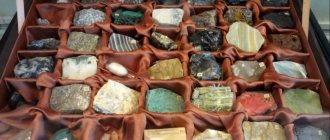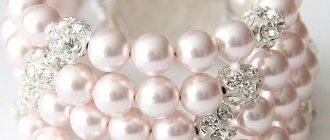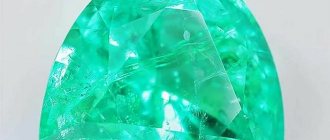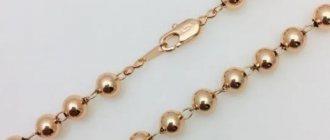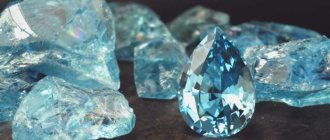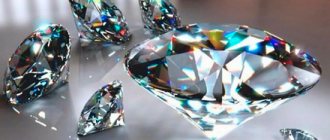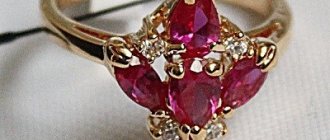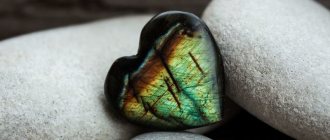Why are such gems valued?
Green stones enjoy well-deserved respect:
- This color is considered the embodiment of natural harmony; its contemplation suppresses negative emotions, bringing peace;
- Bright green color inspires optimism, cheerfulness and confidence;
- Green color symbolizes peace and security.
For many people, green stones are primarily a money talisman. Bankers, financiers or people who want to get rich carry jewelry with them.
Properties of green stones
Since ancient times, green stones have been considered healing. This color represented living nature - grass, foliage, plants.
It was believed that contemplation of green crystals could restore vision and alleviate eye diseases, and the use of individual minerals could help with a number of more serious ailments.
Thus, lithotherapists recommend wearing moldavite bracelets for people suffering from fluctuations in blood pressure, and rings with emerald for those who suffer from depression or are in a state of constant stress.
Beryl can speed up metabolism, malachite will help with asthma, a jade massager is recommended for lower back or joint pain, and green garnet will restore male strength.
It is believed that opaque minerals of a rich green color have the most powerful healing effects.
Esotericists also recommend having one or more jewelry with green precious inserts in your arsenal. Thus, gold earrings with emeralds can dispel negative energy directed at their owner, and a rare green diamond will become an invaluable amulet for the expectant mother and baby.
Beryl talismans can protect against the evil eye, chrysoberyl will attract good luck, chrysolite will increase self-confidence, and sapphire will attract financial well-being.
Artificial
Green varieties of minerals are often mined separately. Therefore, people have learned to produce them by heat treatment or irradiation. An artificial mineral is not considered a fake because its texture remains natural. Often manufacturers do not hide the origin of the stone.
For example, the Kaliningrad Amber Plant produces jewelry imitations of green amber - bernite and buranite. These are natural raw materials combined with natural resins.
The most famous examples are cubic zirconia and moissanite. A product of technology, an analogue of diamonds, recognized only with the help of specialized equipment.
Green cubic zirconia
Classification of stones and minerals
regarding the classification of jewelry stones . Specialists of various professions tried to systematize various stones (in particular, jewelry) according to different criteria: geologists - by place of birth, mineralogists - by chemical composition, trade workers - by cost, industrial workers - by ability to be processed.
Therefore, the classification of different authors is very different from each other. For a long time, the classification of M. Bauer - A. E. Fersman was used, but over time the terms “precious”, “semi-precious”, “colored stones” became outdated, the concept of “gems” changed, many new minerals were discovered, and the old methods of classification no longer met the needs Sciences.
Other classifications of jewelry stones were introduced, for example, “General Classification of Jewelry and Ornamental Stones” by E. Ya. Kievlenko. It is more familiar to jewelers. The table based on it is simple.
It contains all the natural stones that jewelers encounter in their work. They are divided into 3 large groups. In groups, stones are arranged in descending order of their value.
General classification of jewelry and ornamental stones E. Ya. Kievlenko
| Group | Order | Name of stones |
| Jewelry (precious) stones | I II III IV | Diamond, emerald, ruby, blue sapphire Alexandrite; orange, green and purple sapphire; noble black opal; noble jadeite Demantoid, spinel, noble white and fire opal, aquamarine, topaz, rhodolite, tourmaline Chrysolite, zircon; yellow, green and pink beryl, kunzite, turquoise, amethyst, pyrope, almandine, moon and sun stone, chrysoprase, citrine |
| Jewelry and ornamental stones | I II | Lapis lazuli, jadeite, jade, malachite, charoite, amber, rock crystal Agate, amazonite, hematite, rhodonite, opaque iridescent feldspars (belomorite, etc.), iridescent obsidian, epidote-garnet and vesuvian rodingides (jades) |
| Ornamental stones | Jasper, marble onyx, obsidian, jet, petrified wood, listvenite, patterned flint, graphic pegmatite, fluorite, aventurine quartzite, selenite, agalmatolite, colored marble, etc. |
Today, it is generally accepted to classify minerals by class, that is, by chemical composition. Classes, in turn, are divided into subclasses and groups. This classification is convenient for studying stones, because each class includes a mineral and its varieties, forming, as it were, families.
Magic properties
According to the zodiac, green stones are more suitable for representatives of the Earth and Fire triad.
The properties of green minerals are beneficial for people: stones prevent spontaneous, hasty actions or words. They bring peace and harmony to everyday life.
In addition, each green stone is individually useful:
- Green diamond harmonizes family relationships. It is a talisman for pregnant women and protects the unborn child.
- Emerald is a protector against dark forces and helps to find and maintain love or family ties.
- Green sapphire is an attribute of businessmen and creative people. The first will ensure financial success, the second will help you find yourself and unlock your potential.
- Jewelry with peridot is worn when a person is overcome by depression or when the strength of spirit weakens.
- It also protects against corruption, the evil eye and physical aggression.
- Green garnets help when luck or prosperity is lacking.
- Alien forms are used to cleanse the aura or develop intuition.
- Beads or necklaces made of green onyx are the key to family well-being.
Bankers, financiers, gamblers and people with an adventurous streak consider money-colored stones to be their talismans.
Description
There are relatively many green gems, including both well-known ones (emerald, malachite) and not so well-known ones (tsavorite, moldavite). The color palette includes various shades - emerald, yellowish, salad, herbal, grayish. Some of them are the hallmarks of crystals, for example, emerald is characteristic primarily of emerald.
Precious and semi-precious stones of green color are transparent or translucent. Most have a glassy sheen. Uvarovite and demantoid are characterized by a diamond-like luster, but weaker than that of diamonds.
Ornamental green minerals are opaque or translucent in thin chips. They are not only inserted into jewelry, but also used to make crafts - figurines, boxes, vases.
Precious
According to Federal Law No. 41-FZ of March 28, 1998 “On Precious Metals and Precious Stones,” the latter include diamond, ruby, sapphire, emerald, alexandrite, natural pearls, and unique amber formations.
In addition to emerald and alexandrite (in daylight), diamonds and sapphires can acquire an unusual green color. Then an indication of color is added to their name.
In nature, green gemstones are rare and amazingly beautiful. They are transparent, rich in color, and sometimes have a strong shine. But only natural samples are classified as precious.
Emerald
The most famous of the green minerals. Its features:
- is a chromium-containing variety of beryl;
- characterized by elongated prismatic crystals with a hexagonal cross-section;
- has high hardness and scratches glass easily;
- For jewelry inserts, the “emerald” cut is most often used, which reveals the depth of color.
The best examples of emerald come from Russia (emerald mines of the Urals), Colombia, India, and South Africa.
Alexandrite
A rare jewelry variety of chrysoberyl is natural alexandrite. Ural and Sri Lankan samples have a beautiful green color in natural light, and turn red in electric light. Their instability is due to the presence of impurities, including chromium: they shift the absorption bands when the spectral composition of light changes.
Sapphire
Even more rare are green sapphires (chlorosapphires), sometimes having bluish or yellowish tints. Color features are associated with a specific location in the structure of divalent and trivalent iron. Such sapphires are mined in Australia, Thailand, India, Myanmar (formerly Burma), and the Khibiny Mountains.
Diamond
Another rare mineral is green diamond. It owes its color to a combination of two factors:
- the presence of nitrogen in certain proportions;
- irradiation during crystallization with thorium and uranium.
Natural stone is extremely expensive due to its rarity. Sometimes less valuable diamonds that have been artificially irradiated come onto the market. They can be distinguished using special equipment.
Semi-precious
If minerals are beautifully colored, transparent or translucent, but more widely distributed, then they are classified as semi-precious. They are used primarily for making jewelry. The most famous green semi-precious stones are chrysolite, beryl, chrysoberyl, garnets, tourmaline, and moldavite.
Chrysolite
A jewelry variety of olivine with a bright yellowish, golden-green color. The production centers are South Africa, Tanzania, Yakutia, but the best samples came from Egypt.
Beryl
In addition to precious emerald, there is simple green beryl. It got its color not from chromium, but from divalent iron ions. This species does not even have a faint emerald tint. It is light green, bottled, and costs much less. However, products with pure transparent beryl are very attractive.
Chrysoberyl
Green stone most often has a yellowish tint; olive specimens are less common. This gem is very hard, and after cutting it acquires a beautiful shine, creating a sunny aura. If it contains thread-like inclusions of other minerals or tubular cavities, it acquires grayish-greenish shades with light, almost white tints - this is chrysoberyl “cat's eye”.
Pomegranate
Green gems of this group are represented by the following varieties:
- demantoid, with brilliance like a diamond;
- uvarovite, the crystal size of which is about 1 mm;
- tsavorite is a jewelry variety of grossular.
Demantoid
Demantoid (in ancient Greek - “diamond-like”) is a rare variety of andradite garnet with an emerald or yellowish-green color. It was discovered in the Urals, where the best samples are still mined. But initially there was confusion in the names: the mineral was considered chrysolite; Only later was it established that it belonged to the group of garnets.
The presence of diamond shine allows the cut gem to sparkle and shimmer in the light. Due to the presence of these qualities, scientists have proposed adding demantoids to the group of precious stones, but such a decision has not yet been made.
Uvarovite
Emerald, grass-green chrome-containing garnet with high luster. It occurs in the form of small rhombic dodecahedrons (crystals with twelve rhombic faces). They cover the walls of usually black rock with a sparkling crust. The peculiarity of this gem is that it is not cut, but uses natural shapes. In this case, the blanks for the inserts are cut out together with the parent rock, hiding it under the frame.
Grossular
Light green garnet gets its color from ferric iron. More or less large crystals are most often clouded, which negatively affects the appearance of the cut.
But in the second half of the twentieth century, tsavorite (tsavorite) was discovered - an iron-free grossular from Tanzania, containing vanadium, chromium, and nickel. It is represented by transparent jewelry-quality samples, light green or emerald.
Verdelite
A variety of tourmaline, represented by olive-green transparent crystals, sometimes colored khaki. The cut can be either stepped (emphasizes the richness of the color) or more complex (allows you to focus on the shine and weaken the marshy tint of the stone).
Moldavite
Of particular interest is moldavite (vltavin, bottle stone) - a transparent, dark green tektite (natural glass) of quartz composition. It was found only in the Czech Republic and has two versions of origin:
- the impact of the impact energy of meteorites, which melted rocks and scattered frozen droplets over a large area;
- fragments of a comet that did not completely burn up in the earth's atmosphere.
Ornamental
This group of minerals is more widespread on the planet; they form large aggregates or individuals, which makes it possible to make not only jewelry inserts from them, but even vases. Ornamental green stones - chrysoprase, jade, jadeite, malachite, serpentine, quartz cat's eye, amazonite.
Nephritis
Another name is jade, which is an aggregate of fine-fiber amphibole, very viscous and durable. The onion-green color of various shades is due to chromium impurities. Most often it is complicated by white or black veins, spots, and dots. In China, jade was considered priceless.
Chrysoprase
This is the name of the nickel-containing variety of chalcedony. This is a light green, apple, light green mineral, translucent in thin chips.
Jade
It belongs to the group of pyroxenes and has a matted fibrous structure. The color ranges from pale greenish to emerald. Opaque samples predominate. Translucent, richly colored stones (jade imperial) are rare and very valuable.
Malachite
One of the most famous and legendary opaque minerals. In the 18th-19th centuries, Ural stone was highly valued. Since the second half of the 20th century, the market has been filled with Zairian designs in both striped and patterned designs.
Coil
Another name for serpentine is serpentinite; its pattern structure and marsh-green color are similar to snake skin. This is a very soft stone that can be easily ground and polished, which is why it is used to make economy class souvenirs.
Amazonite
A bright green variety of feldspar with white veins. Looks very good in silver and nickel silver items.
cat's eye
It is a type of quartz. This is a light gray-greenish stone, capable of producing even lighter silky shimmers. The effect occurs due to fine-needled, hair-like inclusions of amphiboles.
Therapeutic effect
The influence of green stones on humans is extremely positive:
- People have noticed that just looking at the lush greenery of a tree for a while is enough to rest your eyes and improve your mood.
- Yogis have established a connection between the green hue and the heart chakra. It heals mental wounds, normalizes heart rate and blood pressure. Headaches, including migraines, subside.
- Lithotherapists supplemented these observations by expanding the meaning of these minerals. For example, they have been found to protect against radiation.
Natural green stones strengthen the body as a whole, activating its reserves. The body works like a clock. Contemplating them improves vision.
Opaque minerals are considered particularly powerful healers.
Main conclusions
Green gems are extremely popular due to the positive energy of this natural shade.
- Most green gemstones are rare varieties of the base mineral and therefore cost more (garnet is an exception).
- Semi-precious stones are used not only in the jewelry industry, but also in the production of interior items and premium items (bags, accessories).
- Precious stones are framed in gold and platinum, less valuable in silver and jewelry alloy.
- Ornamental species are often used as material for inlays.
- Ornamental species can be used in the manufacture of furniture.
The scope of application of green stones is unusually wide. The same mineral can be used to make exquisite jewelry and to surround a fireplace. The popularity of gems is due not only to the main tone, but also to the rich color palette with a variety of inclusions, which only emphasize the beauty and uniqueness of the material created by nature.
Share your impressions of what you read and leave feedback in the comments.
Decorations
Stones of this variety are inserted into jewelry taking into account the jewelry value and shade of inlay:
- bright yellow or white gold, platinum is suitable for transparent gemstones of deep green color;
- semi-precious stones go well with sterling silver;
- precious stones are set in cupronickel;
- Artificial stones (except cubic zirconium and moissanite) are costume jewelry made of jewelry alloy or medical steel.
The wearing “code” is similar to other colored minerals: the older the wearer, the larger and darker the inlay.
Green colors are effective in sets: earrings plus a ring/necklace/bracelet; cufflinks plus a tie pin.
However, don't go overboard with the size of the inlay. A brooch, ring, pendant or bracelet with large sparkling stones can look vulgar. Especially jewelry with artificial precious stones.
Classification of gemstones
The classification of precious stones was compiled back in the 19th century. In 1896, M. Bauer developed a classification of precious stones. Later, Russian academician A.E. Fersman expanded and supplemented it.
Currently, this classification option is considered obsolete.
According to this classification, jewelry and semi-precious stones are divided into three groups:
- precious stones (gems),
- ornamental (colored stones),
- Organogenic precious stones.
In the first two groups, the stones are divided into orders of magnitude depending on the value of the stones.
Modern classifications of precious stones
Today, refined and simplified versions of the Bauer-Fersman classification are used.
Classification by V. I. Sobolevsky
1. Precious stones (gems)
1 class:
diamond, emerald, alexandrite, chrysoberyl, euclase, noble schlinel and especially rare varieties of corundum: ruby, sapphire, padparadscha (orange sapphire).
2nd grade:
topaz, varieties of beryl (aquamarine, sparrowite, heliodor), pink and dark red tourmaline (siberite), phenacite, amethyst, zircon (orange hyacinth, green, etc.), noble opal.
3rd grade:
turquoise, rock crystal (colorless and smoky rauchtopaz), chrysoprase, carnelian, agates with beautiful designs, bloodstone, amber, jet, etc.
2. Colored stones
1 class:
malachite, rhodonite, jade, lapis lazuli, amazonite, labradorite, aventurine, chalcedony, written granite, etc.
2nd grade:
ophiocalcite, agalmatolite, marble onyx, fluorite, selenite, jasper, meerschaum, etc.
Household classification
Simplified classification (household). Here stones are divided into precious, semi-precious and semi-precious (gemstone).
First grade precious stones: diamond, sapphire, ruby, chrysoberyl, alexandrite, emerald, lal, spinel, euclase.
Second grade gemstones: topaz, aquamarine, beryl, red tourmaline, demantoid, phenacite, blood amethyst, almandine, hyacinth, opal, zircon.
Semi-precious stones: garnet, epidote, dioptase, turquoise, green and variegated tourmalines, pure rock crystal, rauchtopaz, light amethyst, chalcedony, very high quality sun and moonstone labradorite.
Gemstones: jade, lapis lazuli, bloodstone, amazonite, labradorite, varieties of spar and jasper, Vesuveman, smoky and rose quartz, jet, amber, coral, mother-of-pearl.
Classification by E. Ya. Kievlenko
One of the best recognized classifications is considered to be the one proposed by Professor E. Ya. Kievlenko. In 1973, he proposed his system (based on Fersman's classification). The market value of colored stones is taken into account here.
The first group is jewelry (cutting, precious) stones
1 class:
diamond, emerald, blue sapphire, ruby.
2nd grade:
alexandrite, noble jadeite, orange, yellow, purple and green sapphire, noble black opal.
3rd grade:
demantoid, noble spinel, noble white and fire opal, aquamarine, topaz, rhodolite, moonstone (adularia), red tourmaline.
4th grade:
blue, green, pink and polychrome tourmaline, noble spodumene (kunzite, giddenite), zircon, yellow, green, golden and pink beryl, turquoise, peridot, amethyst, peridot, chrysoprase, pyrope, almandine, citrine.
The second group is ornamental (stone-cutting) stones
1 class:
rauchtopaz, hematite (bloodstone), amber-succinite, rock crystal, jadeite, jade, lapis lazuli, malachite, aventurine.
2nd grade:
agate, colored chalcedony, cacholong, amazonite, rhodonite, heliotrope, rose quartz, iridescent obsidian, common opal, labradorite, belomorite and other opaque iridescent spars.
The third group - decorative facing stones
Jasper, written granite, petrified wood, marble onyx, larchite, obsidian, jet, jaspilite, selenite, fluorite, aventurine quartzite, agalmatolite, patterned flint, colored marble.
Why do you dream of green stones?
Dreamers associate this range with everyday things. If you dreamed of green stones, success in business, profit, a successful marriage is just around the corner:
- Miller. If you found a large shiny stone in a dream, in reality expect success in personal business projects and wealth in general.
- Vanga. If you dreamed that you found a gem, you will get new opportunities in your personal and professional life.
- Tsvetkov. Such stones in your dream portend super-success in business or risky projects. We cannot rule out pleasant surprises in other areas.
- Chinese book of dreams. Seeing such stones in a dream means no physical health problems in the near future. Such a dream is an especially good sign for sick people: the disease will not persist.
A separate interpretation is the dream of jewelry with green stones:
- You received gold earrings, a pendant, a brooch or other jewelry with such an insert (especially a ring) - expect a marriage proposal soon. Don't reject him: the marriage will be successful.
- The loss of jewelry with a stone foreshadows a quarrel or disagreement with your “other half.”
- Wearing a ring with a green stone means that you will receive a promotion at work or a career in business. Or otherwise elevate yourself above your environment. You may receive an inheritance, which may cause tension in the family.
- A ring or signet with such a stone on the finger speaks of unexpected, stable profits.
- If you find a ring and it turns out to be small, think about the relationship: it is outdated.
If the stone in your jewelry turns out to be fake, be careful. Perhaps disappointment in a business partner, children or spouse.
Classification of precious, semi-precious and ornamental stones
Very often our visitors are interested in which stones are classified as precious, which are semi-precious, and which are considered ornamental?
Classifications for dividing stones into precious, semi-precious and ornamental exist, but in different countries these classifications have their own characteristics and differences.
Now the most famous and used in Russia and the CIS countries is the classification of E.Ya. Kievlenko.
Jewelry gemstones
I order: diamond, emerald (green beryl), ruby and blue sapphire (corundum).
II order: alexandrite, orange, yellow, purple and green sapphire, noble black opal, noble jadeite.
III order: demantoid, spinel, noble white and fire opal, aquamarine, topaz, rhodolite, tourmaline.
IV order: chrysolite, zircon, yellow, green and pink beryl, kunzite, turquoise, amethyst, pyrope, almandine, moon and sun stone, chrysoprase, citrine.
Jewelry and semi-precious stones
I order: lapis lazuli, jadeite, jade, malachite, charoite, amber, rock crystal, smoky quartz (rauchtopaz).
II order: hematite-bloodstone, rhodonite, opaque iridescent spar (belomorite, labradorite and others), iridescent obsidian, epidote-garnet and vesuvian rodingites - jade.
Ornamental stones
Jasper, marble onyx, obsidian, jet, petrified wood, listvenite, jaspilite, selenite, fluorite, aventurine quartzite, agalmatolite, patterned flint, colored marble.
